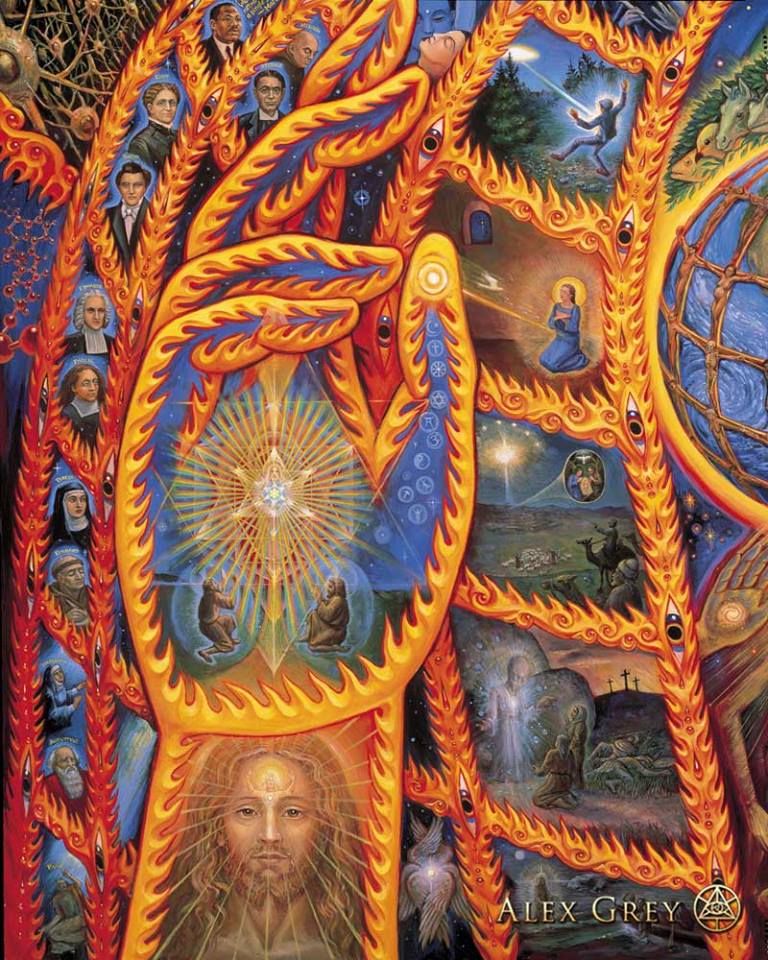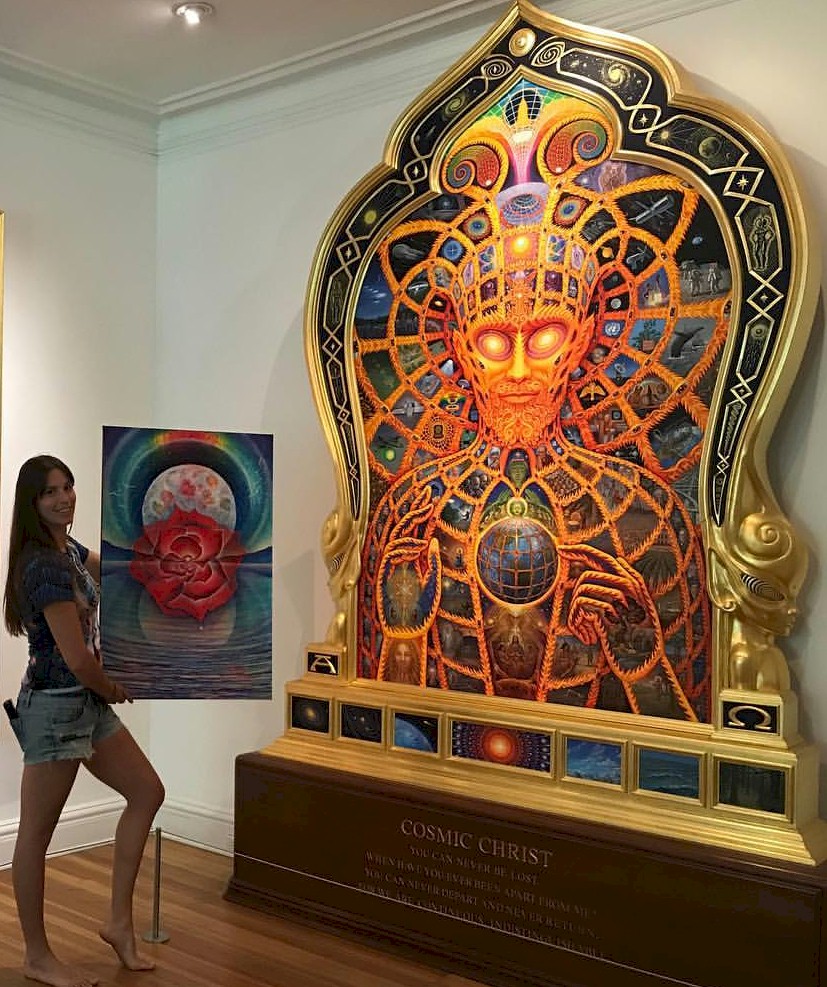If You Were an Artist, How Would You Paint the Universal Christ?
Picturing the Universal Christ
A common view of art is that art is primarily a recognizable image. But the Universal Christ is not a recognizable image—it does not “have” an image. Fortunately, art is much more than an image. It is a dynamic connection between form and content. The popular view is that art should require no effort to “get it.” Contemporary art, like the image above, especially eludes this kind of simple viewing.
Here are three points that can help unravel modern art such as Alex Grey’s Cosmic Christ adapted from art historian Daniel A. Siedell:
1. Modern art is more theologically realistic than traditional art. The awkward, clunky, and strange-looking works of the modern period operate as painted theologies that declare our terror, vulnerability, fragility, and disasters—not pictures of the glory to come and the beauty to which we aspire. They’re not always intended to inspire or elevate, but through their vulnerability, weakness, and fear, they give us glimpses or intuitions of God’s grace. But they require the viewer to first look beyond the obvious, and second, to be receptive to whatever that painting may make them think or feel.
2. Modern art Is about truth, not affirmation.
Siedell writes, “An artist doesn’t make a work of art to be glanced while we absentmindedly walk by or scroll through our Instagram feed. It requires us to stop in front of it and allow the painting to make the first move, so that our response is a thoughtful engagement.”
3. Modern art Is uncomfortable
Grey’s Cosmic Christ is not pleasant looking but fearsome. There is often suffering or a cross at the center of contemporary art as in the Cosmic Christ. It invites us to honestly acknowledge the darkness, ugliness, and evil that exists not only in the world but also in us before we can truly give thanks and glory to God for it. Modern art is not about affirmation, but about inviting us to think and feel deeply.
Siedell says, “Ultimately, what confuses all of us about modern art is that it seems to contradict what we think art is about, which is rendering “realistic” representations of the world as we already know it. Modern art reveals that the visual arts have always been about that ‘something more’ or ‘something other’ that cannot be reduced to brute fact.”
The Cosmic Christ
Here are five more of the six Universal or Cosmic Christ paintings to which I am drawn, four of which hang in large size on the walls of my living room. Their artists have titled five of them “Cosmic Christ” and one “Cosmic Embrace.”
Cosmic Christ by Jozef Klopacka
Imaging the Universal or Cosmic Christ is a challenge because it must point to the vastness of creation— everything—and the particularity of the man from Nazareth, Jesus.
These two paintings attempt this by using vast, perhaps infinite, cosmic space as a background with a cosmic sized transparent image of Jesus.
Cosmic Christ by John Lenz
Cosmic Christ by Sister Rebecca Shinas
In her Cosmic Christ, Sister Shinas uses a cosmic spiral as a metaphor for the “cosmic” dimension with the Living Jesus in the center. We see that spiral in outer space in such photos from the Hubble Space Telescope as this one of Spiral Galaxy NGC 1232.
Cosmic Embrace by Melina del Mar
In the Cosmic Embrace by Melena del Mar, a feminine Christ is presented as Sophia, the New Testament Greek word for wisdom. Anchored in the Old Testament personification of Sophia (Wisdom ) as God (Prov 8), Jesus is explicitly described as personified Wisdom in Mat 11:19. Jesus is Sophia's son who communicates her wisdom to humanity in Luke 7:35; and Paul in I Cor 1:17-2:6 delights in Christ Sophia. In 1 Cor 1:24 Paul refers to Christ as the “power of God and the Wisdom (Sophia) of God” and states that Christ “became for us Wisdom (Sophia) from God” (1 Cor 1:30). Origen, a prominent early Christian writer, declared Sophia to be the most ancient and appropriate title for Jesus.
Notice how more information makes contemporary art more meaningful. For instance, illuminating this last image, Sister Annett Hanrahan writes:
I live in the South Pacific, in New Zealand, which is a multi-cultural country, including Maori, Polynesian, and peoples from all parts of Asia. I could not find any images that spoke to me or to any of us of a powerful, loving God . . . I wanted to probe the incarnational reality of God in Christ and in all of creation in a language that might have some meaning in my world.
So, Christ is seated in a posture similar to the prayer posture of many in the east, and of the Polynesian peoples of the Pacific. His features have a Polynesian quality. He is holding his cross, which is transparent, for it is part of, and dialogues with, the earth, but Christ has moved beyond it. Christ’s eyes are closed as he is one with His Father, and in that deep communication, he is a powerful and strong channel, river even, of the flow of the love of God to slake our thirst.
Cosmic Christ by Sr Annett Hanrahan
Now let’s return to Alex Grey’s provocative Cosmic Christ.
Cosmic Christ detail by Alex Grey
Alex Grey’s works have become icons of the contemporary spiritual movement by virtue of their power to inspire, inform, and illuminate the inexplicable.
He takes a unique approach in his Cosmic Christ. I think he gets closest to the Universal or Cosmic Christ as “everything that has ever happened held in seamless Oneness.”
Grey attempts to represent everything that has happened by presenting over 100 events in the evolution of creation. It begins with the big bang and ends with our future exploration of outer space and other sentient forms of life that may be found in space in the future.
These are all encased in the golden web of life that is Christ, beautifully imaging that “all things have been created through Christ and for Christ” (Col. 16).
Original Cosmic Christ by Alex Grey
Cosmic Christ detail by Alex Grey
The heart of Cosmic Christ, for us, is the planet Earth. A longitude and latitude grid over Earth becomes a planetary crucifixion; with Jesus in the center, everyone is nailed together in collective suffering. The planetary crucifixion transforms into a green Christ child, a planetary child, a green tree of life with all the plants and animals as one being.
Below the painting it reads:
You can never be lost.
When have you ever been apart from me?
You can never depart and never return.
For we are continuous, indistinguishable.
Practice
Instead of “absentmindedly glancing” at these images, take your time to listen to your head, heart, and gut as you look thoughtfully at them. What do you think, feel, and sense that opens the Cosmic Christ to you more deeply?
If you are able to enter a transcendent or unity consciousness, look at Grey’s Cosmic Christ from this place. Or simply imagine that you are seeing these many events of evolution as not just happening “out there” and “back then” but as “inside of you” and “all in the present.” You are these events!
Like these reflections? Join our mailing list to receive more writings from Paul Smith and Integral Christian Network.









